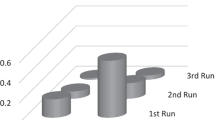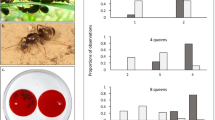Abstract
Many benefits and risks of cooperative colony founding (pleometrosis) have been identified, but rarely have the proximate factors that lead to association been considered. This study examined the choices queens make during the first few hours after mating, and some of the correlates of those choices. Queens had a strong affinity for preformed holes in the soil and readily used these as their initial founding chambers. This affinity was so strong that in a field experiment, the dispersion pattern of preformed holes controlled the final dispersion of colony-founding queens. Attraction to partially formed holes is thus an important cause of pleometrosis. The excavation of complete founding chambers incurred no measurable cost on the subsequent reproductive output of queens, suggesting that the primary benefit of using preformed holes is to remove the queen quickly from exposure to predation and desiccation. In the field, pairs of queens offered five equivalent preformed holes in soil were more likely to share the same hole if the holes were shallow and close together. In these experiments, queens modified preformed soil holes so that the test holes were no longer equivalent, causing the choice of queen and hole to become confounded. Laboratory experiments in plaster arenas with unmodifiable holes confirmed the field experiments: queens were more likely to share a hole when the holes were shallow than when they were deep. Because queens entering adequately deep holes seldom reemerged, this suggested that the likelihood of sharing increased with increasing contact between queens, that is, when queens were readily and frequently detected. Such contacts will also predict the future competitive environments to be experienced by incipient colonies, and may temper the tendency of queens to associate. However, experiments in which queens were exposed to high and low densities before pairing in the choice arenas failed to show an effect on the choice to join the resident queen. Queens that joined a resident queen differed in their robustness from queens that did not join. Queens choosing their own partners did no better reproductively than those assigned partners at random. Overall, this study suggests that (1) newly mated queens are under strong selection to leave the soil surface and do so by using any available holes, whether dug by another queen or of some other origin; (2) they are attracted to other queens, and are more likely to cofound as contact with the potential cofoundress becomes more frequent and (3) they choose whether or not to cofound partly on the basis of their own reproductive characteristics.
Similar content being viewed by others
Author information
Authors and Affiliations
Additional information
Received: 20 November 1997 / Accepted after revision: 14 March 1998
Rights and permissions
About this article
Cite this article
Tschinkel, W. An experimental study of pleometrotic colony founding in the fire ant, Solenopsis invicta : what is the basis for association?. Behav Ecol Sociobiol 43, 247–257 (1998). https://doi.org/10.1007/s002650050489
Issue Date:
DOI: https://doi.org/10.1007/s002650050489




